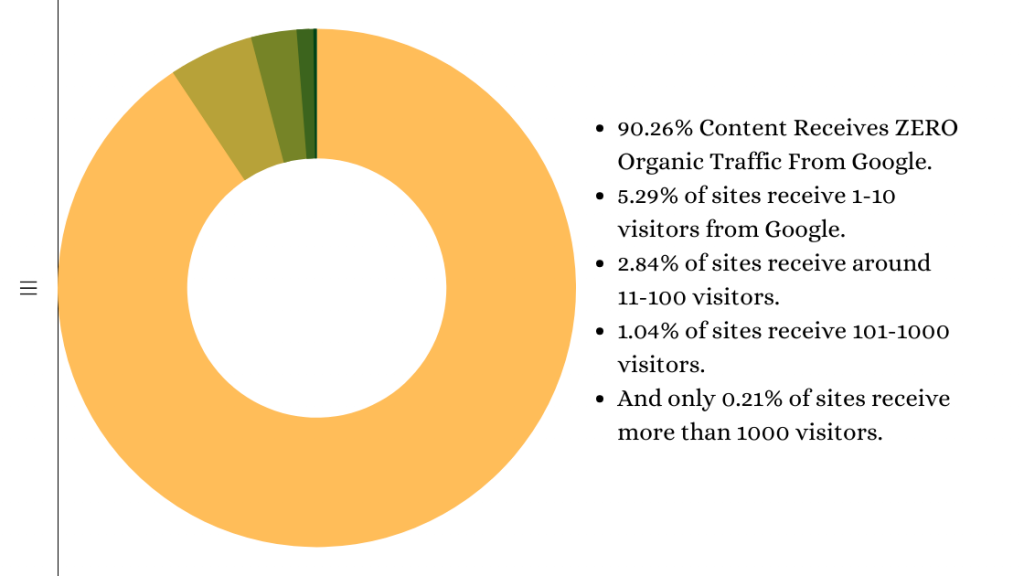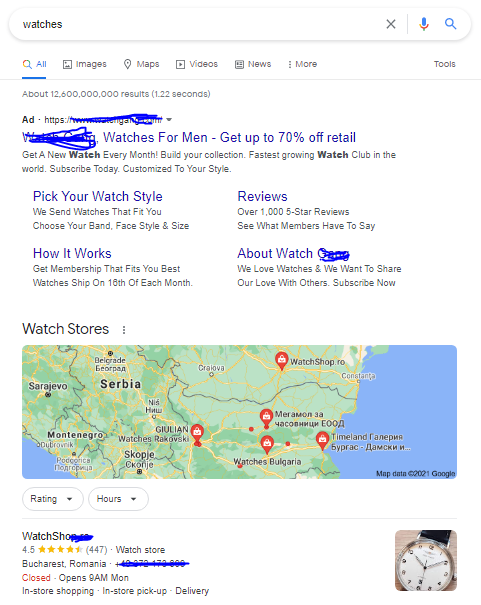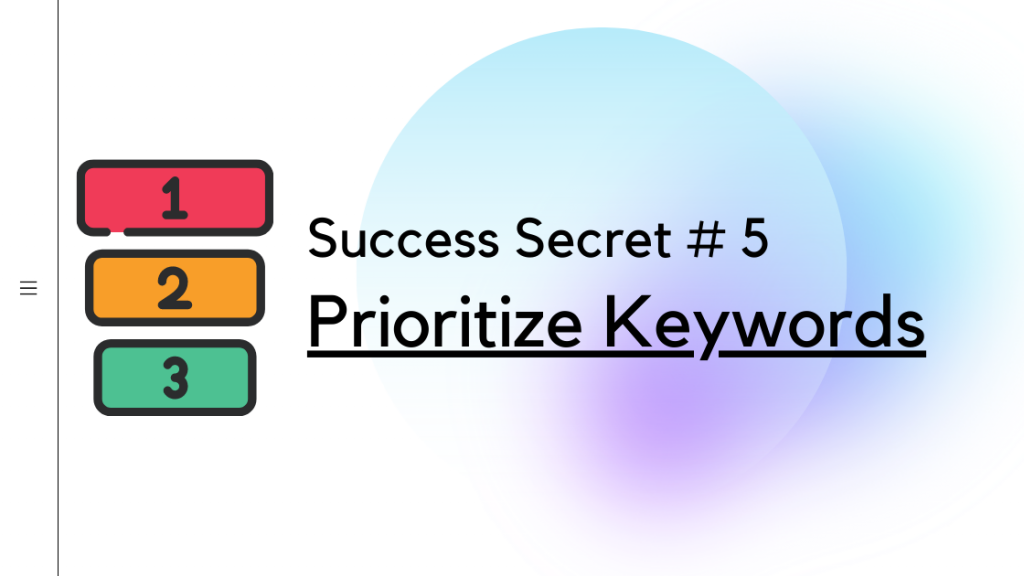Address
304 North Cardinal St.
Dorchester Center, MA 02124
Work Hours
Monday to Friday: 7AM - 7PM
Weekend: 10AM - 5PM

Let’s go through the basics of keyword research before we get into the nitty-gritty of how to find the ideal keywords for your business.

The act of determining the words your target clients use when looking for your products, services, and content is known as keyword research. The next step is to evaluate, compare, and prioritize the best keyword opportunities for your website. What is the significance of keyword research? The only way to figure out what people are putting into search engines is to conduct keyword research. You should be aware of this to avoid writing material about topics that no one is looking for.
Many website owners make this error, and it’s most certainly one of the reasons why, according to our research, 90.63 percent of pages receive no traffic from Google.

Keyword research can also assist you in answering issues such as:

Consider how potential buyers could search for your company or website while conducting keyword research. After that, you can utilize keyword research tools to elaborate on those concepts and discover even more keywords.
It’s a simple procedure, but two things must be true for it to work properly:
In this chapter, we’ll go over a few practical techniques to strengthen your understanding in both of those areas while also uncovering potentially profitable keywords for your website.
The core of the keyword research process is seed keywords. They assist you in defining your specialty and identifying your competition. Every keyword research tool requires a seed term, which it then uses to build a massive list of keyword suggestions. Coming up with seed keywords is simple if you already have a product or service you want to market online.
For example, if you sell Property or Construction service, then seed keywords might be:
Consider what consumers will enter into Google to find what you have to offer. It’s worth noting that seed keywords aren’t always worth targeting with your website’s pages. You’ll use these as “seeds” for the next steps in this procedure, as the name implies. So don’t get too worked up about your seed keywords.
Finding them should just take a few minutes. Move on to the next step once you’ve come up with a few general ideas for your website’s topic.
The easiest method to start keyword research is to look at which terms already drive traffic to your competition. But first, you must determine who your competitors are. That’s where your keyword list from the brainstorming session comes in helpful. Simply type one of your seed keywords into Google and see who comes up first.
For example, you want to build a store to sell watches or talk about watches as an affiliate marketer, you should start with a seed keyword, in this case, watches. And see the results.

Try searching for appropriate ‘autosuggest’ queries instead if none of the top-ranking websites for your seed keywords are similar to your site (or where you’re attempting to take it). If you sell building design services, for example, you might find more actual competitors in the search results for “construction services” than “design services,” because the former is dominated by construction firms like yours, while the latter is dominated by software houses.
In our case we are looking for watches, and here is the result of Google keyword suggestions as shown in the figure below.

In either case, while determining rival websites, you must use your best judgment. You shouldn’t necessarily treat large firms like Amazon or The New York Times as competition if they rank for your seed keyword. Always look for websites that are similar to yours—or the direction you want to take it. Once you’ve found a few websites that suit the bill, enter them one by one into a competitive intelligence tool (which we’ll cover in a future session) and verify the Top Pages report. After that, you’ll see their most popular pages ranked by estimated monthly search traffic. The “top keyword” for each page is also displayed in the report. That’s the source of the majority of its organic traffic.
We added the term watch in Ahrefs free tool and found the top-ranking pages, below is an example. You can have a look at their estimated traffic, the number of backlinks (we will discuss backlinks in the future), DA, PA, and other ranking factors including other keywords the same page is ranking for.

Here are a few interesting keywords we discovered for our hypothetical design company, just by analyzing one competing website with an SEO tool:
As you can see, even if you’re very knowledgeable about your market, examining your competitors can provide you with plenty of unique keyword ideas that you wouldn’t have gotten through brainstorming alone.
If you’ve looked at all of the competitors in the search results but still need more keywords, go to Site Explorer’s Competing Domains report. Simply enter one of your well-known competitors, and it will recommend other sites that are similar to yours based on the number of overlapping terms that they rank for on Google.
Competitors might provide tons of keyword suggestions. However, there are many terms that your competitors aren’t targeting, which you can discover utilizing keyword research tools. All keyword research tools operate in the same manner. You enter a seed keyword, then they search their database for keyword suggestions based on that keyword. The most well-known keyword tool is Google Keyword Planner. It’s free to use, and while it’s geared for marketers, you may use it to identify SEO keywords.
We used the seed keyword watches and see the results along with ranking difficulty and the freshness date of results.

You can generate tons of keywords.
You’ll note that Google Keyword Planner is intelligent enough to provide you with useful keyword suggestions even if they don’t contain your seed keywords. There are other free keyword research tools available in addition to Keyword Planner. If you’re on a budget, these are fantastic, but you’ll immediately notice that their data and usefulness are severely limited, as their purpose is to convert you into a paying customer. If you’re serious about keyword research, you can invest in a “professional” tool, which we’ll talk about later.
Everything we’ve covered thus far is sufficient to produce an almost infinite number of keyword suggestions. However, the technique keeps you “in the box” at the same time. It’s constrained by your seed keywords, as well as the size and freshness of the database of your chosen keyword tool.
As a result, you’ll almost surely miss out on some great ideas. You may solve this by digging further into your niche. A smart place to start is to look through industry forums, organizations, and Q&A sites. This can assist you to discover more problems that your potential clients are having that aren’t being addressed by keyword tools and that none of your competitors have thought to address.


It’s all well and good to have a slew of keyword suggestions. But how do you determine which are the most effective? After all, it would be near-impossible to sift through them all by hand. The answer is straightforward: Before adding them to your content calendar, use SEO metrics to narrow things down and separate the wheat from the chaff.
Let’s explore five keyword metrics you can use to do this.
The average number of times a keyword is searched each month is known as search volume. For example, the term “hour” receives 40,000 monthly searches in the United States alone.
Checking for the keyword watches also gives us similar results, please check the image below.

There are three key points to remember about search volume:
There are 171 countries to pick from if you need to check search volumes for a country other than the United States, United Kingdom, or Pakistan. It is always better to start from less competitive markets irrespective of their financial capacity or your interest in that market to avoid equity wastage.
You may also check the total number of searches made around the world (the sum of search volumes from all countries). If you run a business or create blogs/articles for international visitors, both of these alternatives are useful.
You should not confine your business, blog, or website to a single country.
Take, for instance, the keyword “backlink generator.” It has global search traffic of 13,000, but more than 70% of those searches are from low-income nations including India, Indonesia, Bangladesh, and Pakistan. So, while ranking for this phrase could potentially bring in a lot of traffic, the ‘business value’ of that traffic would likely be minimal compared to a term that receives 70% or more of its searches from the United States. Read the below heading (Important Decision) for a better evaluation of the situation and target setting.
Another thing to keep in mind concerning search volumes is that they differ between tools. This is because each tool calculates and updates this metric differently. This is due to the complexities of search volume estimations, as well as why even Google’s statistics aren’t completely “correct.”
Also, keep an eye on google trends or short-life topics usually news topics. And you can use Google trends or search on google to see if the top-ranking pages are from news websites. Not all news topics are short-lived but researching prior to writing is better.
Your decision can vary in different cases. If you are just starting on a low budget, you should start from these countries with low advertising costs and customer retention. this will help you generate your company, blog, website, or business profile. Once you successfully target a wider audience at little cost, you can target your hometown or preferred markets like of US, UK, or UAE. As Google and other search engines are now aware of your website due to your previous six months of high user engagement, your credibility is far higher than any other user on the internet or your competitor.
Otherwise, If you want to avoid time wastage and have money to spend in the local market. You should try finding keywords with low volume but high resemblance or relevance to your business.
Even though a lot of people use Google to look for something, that doesn’t guarantee they all click on the top results and go to the top-ranking pages. That’s where Keywords Explorer’s Clicks metric comes in help. It displays the monthly average number of clicks on a keyword’s search results.
This occurs because Google provides a direct answer to the inquiry in the search results. There is no need for users to click to find the information they need. Google is delivering responses to an increasing number of questions in its search results. That is why using Keywords Tools is so beneficial. It can be used to exclude keyword concepts with little search traffic potential. You should also be cautious of terms where paid advertisements “steal” a large number of clicks.
We will learn this feature in detail, in our KW Research tools tutorial.
This is the number of possible keywords for which your one blog post, website, or article can rank. For example, our blog on how to earn money online in Pakistan is ranking for more than 3 dozen keywords.
Let’s assume you’re considering a keyword like “social media side effects.” This receives an estimated 1,000 searches and 800 clicks every month, according to Keyword Research Tools. Because all of these search inquiries are essentially the same, calculating your future search traffic based on just one search query is a mistake. It’s best to check how much traffic the current top-ranking pages get, which Keywords Explorer makes quite easy. This type of ranking for multiple keywords is extremely common.
We will learn this feature in detail, in our KW Research tools tutorial.
What is the story’s moral? Don’t solely evaluate terms based on their search volume (or clicks). Examine the top-ranking results to evaluate the topic’s entire search traffic potential. In most circumstances, a keyword’s search volume will correspond to the topic’s total ‘traffic potential.’ Being aware of this detail, on the other hand, will assist you in prioritizing your keywords and identifying keyword chances that your competitors have neglected.
Manually determining the ranking difficulty of a keyword is a common practice among SEO pros. That is, by looking at the top-ranking pages for the keyword they are interested in. They take into account a variety of elements to determine how difficult or easy it will be to rank.
Because there is no consensus on what is and isn’t important in this process, it differs from individual to person. One person may believe that DR is vital, while another believes that relevance is more important. This lack of agreement makes things tough for keyword research tool creators, who are all attempting to reduce keyword ranking difficulty to a single actionable score. After speaking with several skilled SEOs about the signs that a reliable Keyword Difficulty score should consider, we discovered that at least one thing was universal: backlinks are critical for ranking.

Knowing how KD works, many people abuse the score by lowering the filter to 0 and concentrating primarily on “low-hanging” possibilities. They don’t cover high-KD keywords on their web pages, which is a huge mistake for two reasons:
In the end, KD isn’t there to keep you from focusing on specific keywords. It’s there to assist you to figure out what it’ll take to rank for a specific query, as well as the topic’s “link-worthiness.” Just keep in mind that you should always carefully examine keywords before pursuing them, rather than relying exclusively on the keyword difficulty score provided by any program. No single keyword difficulty score can capture the intricacy of Google’s ranking algorithm. Be skeptical of toolmakers that claim differently.
The cost per click (CPC) metric indicates how much advertisers are ready to pay for each ad click generated by a keyword. It’s more of an advertising metric than an SEO metric, but it can be a good proxy for a keyword’s worth.
The keyword “office chair,” for example, has a rather high CPC of $12. Because the majority of searchers are searching to purchase office chairs, which can cost hundreds or thousands of dollars, this is the case. In the case of “how to sell a good office chair,” however, the situation is the polar opposite. Because most searchers aren’t trying to buy something, this is the case. They’re trying to figure out how to sell a good office chair.
One thing to keep in mind concerning CPC is that it is far more volatile than Search volume. While the search demand for most terms is relatively constant from month to month, the cost per click (CPC) might alter at any time. As a result, the CPC figures displayed in third-party keyword tools are snapshots in time. You’ll have to use Adsense if you want real-time data.

You must build the appropriate type of page and content for each keyword on your list. Understanding how to do so is an important part of the keyword research procedure. Fortunately, you can do it in two easy steps.
Parent topic identification means that we need to understand how Google sees a particular keyword. For example, if we search for “Digital Marketing,” will google respond by displaying articles on digital marketing or people selling digital marketing services? Now the parent topic can be different in the two cases.
In the case of blog posts defining digital marketing is ranking higher, (we can explore the link and check) it can be an educational website or a financial guide by an expert, or it could be a general information blog by a person with his personal experience about digital marketing.
Whereas, the other case could be services or courses on digital marketing that Google is preferring over everything else. And the post could either be a sales copy, tutorial, or a featured lecture from a digital marketing course.
So, we need to look into the details to identify the parent topic of the search results to understand the flow of Google and the interest of people that helps Google identify and rank certain pages better than others.
Identification of the search intent of the user is somehow related to outcomes of parent topic identification. You need to learn and understand if the keywords show any purchase intent or intent of a user looking for certain information to educate himself about the topic. This could also be understood by looking into the topics or pages ranking higher on Google.
If Google is ranking shops, offices, or business on top of the page for certain keywords, that certainly means that the number of users searching for services or with purchase intent are higher as compared to ones looking for just information. Additionally, there can be videos ranking higher than websites which implies that people are interested in videos.
The top results for a keyword are frequently a good proxy for search intent because Google understands intent better than anybody else. You should develop the same type of content that is already ranking on the first page if you want to have the best chance of ranking.
It is essential to understand content details to better plan your content marketing strategy.
Just remember that, while it’s critical to connect your content with what searchers expect, you don’t necessarily want to follow the crowd and trap searchers in their expectations bubble. Give it a chance if you’re convinced that a different content type, format, or angle will catch searchers’ interest.

Prioritization of keywords isn’t the last stage in the keyword research process. It’s more of a thing you should do as you move through the preceding steps. Ask yourself the following questions as you’re looking for keywords, examining their metrics, and categorizing them:
That latter element is especially significant. While search volume, traffic potential, difficulty, and search intent are all significant factors to examine, you should also evaluate how much traffic from that phrase will cost your company.
The buyer’s journey is used by many content marketers and SEOs to determine the “worth” of keywords. People go through this process before making a purchase. According to conventional opinion, the sooner in a person’s journey they are, the less likely they are to buy. What are people’s methods for accomplishing this?
The most common way is to categorize keyword suggestions into three categories: TOFU, MOFU, and BOFU. Top of Funnel Users, Mid of Funnel Users, and Bottom of Funnel users. However, this is not always the case and we think that this concept is limiting and perhaps even misleading. You can read about it in a case study written by hubposts.

We will discuss Keyword Research Tools in our upcoming articles. However, we are mentioning names of a few famous tools:
Google Keyword Planner (Free)
For its unique keyword suggestions and up-to-date CPC values.
Google Trends (Free)
For trend comparisons and researching the geography of trends. Google Search Console (Free) For checking the top 1,000 keywords you already rank for and how much traffic those keywords send you.
Ahrefs Webmaster Tools (Free)
For checking all the keywords you currently rank for, along with their estimated search volumes, Keyword Difficulty scores, traffic potential, and other useful SEO metrics.
Keyword Generator (Free)
For generating hundreds of free keyword ideas from a seed keyword.
Keyword Difficulty Checker (Free)
For checking the ranking difficulty of a keyword, as per Ahrefs’ Keyword Difficulty (KD) score.
Keyword Rank Checker (Free)
For checking where you rank for any keyword in any country. Keywords Explorer
We will discuss other professional Keywords Research tools for an extended grip over the industry.